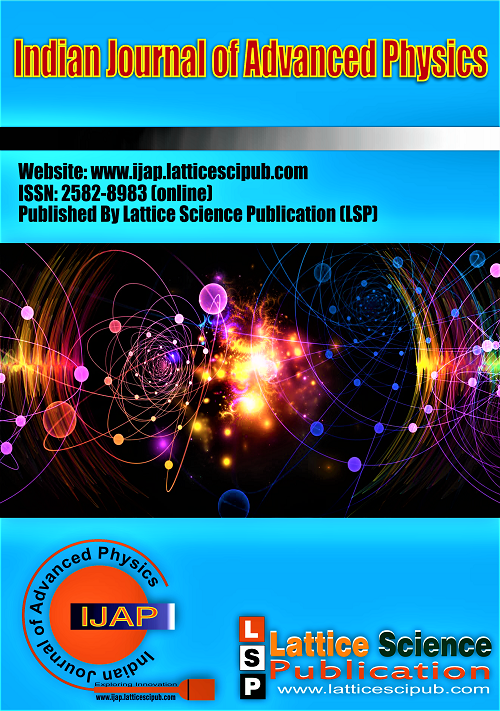Theoretical Investigation of Gravitational Effect on Effective Mass of Electromagnetic Wave
Main Article Content
Abstract
This paper
Downloads
Article Details

This work is licensed under a Creative Commons Attribution-NonCommercial-NoDerivatives 4.0 International License.
How to Cite
References
Einstein, A. (1916). The foundation of the general theory of relativity. Annalen der Physik (Vol. 49, Issue 7, pp. 769-822). DOI: https://doi.org/10.1002/andp.19163540702
Earman J., & Glymour, C. (1980). The gravitational redshift as a test of general relativity: History and analysis. Studies in History and Philosophy of Science Part A (Vol.17, Issue.3, pp.175-214). DOI: https://doi.org/10.1016/0039-3681(80)90025-4
Plebanski, J. (1960). Electromagnetic waves in gravitational fields. Physical Review (Vol.118, Issue.5, pp.1396-1408). DOI: https://link.aps.org/doi/10.1103/PhysRev.118.1396
Pound, R.V., & Snider, J.L. (1965). Effect of the gravity on gamma radiation. Physical Review (Vol.140, Issue.3, pp.788-803). DOI: https://doi.org/10.1007/BF00670996
Sadeh, I., Feng, L.L., & Lahav, O. (2015). Gravitation redshift of galaxies in cluster from the Sloan digital sky survey and the Baryon oscillation spectroscopic survey. Physical Review Letters (Vol.114, Issue.7, p.071103). DOI: https://link.aps.org/doi/10.1103/PhysRevLett.114.071103
Wojtak, R., Hansen, S.H. & Hjorth, J. (2011). Gravitational redshift of galaxies in clusters as predicted by general relativity. Nature (vol.477, Issue.7366, pp.567-569). DOI: https://doi.org/10.1038/nature10445
Muller, H., Peters, A. & Chu, S. (2010). A precision measurement of the gravitational redshift by the interference
of matter waves. Nature (vol.463, Issue.7283, pp.926-929). DOI: https://doi.org/10.1038/nature08776
Will, C.M. (2014). The confrontation between general relativity and experiment. Living Reviews in Relativity (Vol.17, Issue.4, pp.1-117). DOI: https://doi.org/10.12942/lrr-2014-4
Scott, R.B. (2015). Teaching the gravitational redshift: lessons from the history and philosophy of physics. Journal of Physics: Conference Series. (Vol.600, Issue.1, p.012055). DOI: https://doi.org/10.1088/1742-6596/600/1/012055
Chang, D.C. (2018). A quantum mechanical interpretation of gravitational redshift of electromagnetic wave. Optik (Vol.174, pp.636-641). DOI: https://doi.org/10.1016/j.ijleo.2018.08.127
Khadka, C.B. (2023). Determination of variation of mass with gravity. Journal of Nepal Physical Society (9, Issue.1, pp.129-136). DOI: https://doi.org/10.3126/jnphyssoc.v9i1.57750
Khadka, C.B. (2022). Relative nature of electric permittivity and magnetic permeability of electromagnetic wave. Indian Journal of Advanced Physics (vol.2, Issue.1, pp.17-25). DOI: https://doi.org/10.54105/ijap.C1021.041322
Khadka, C.B. (2023). Biot-Savart law for determination of speed of particle beyond the speed of light. Indian Journal of Advanced Physics (vol.3, Issue.1, pp.1-5). DOI: https://doi.org/10.54105/ijap.A1035.043123
Khadka, C.B. (2023). Extension of Maxwell’s Equation for Determination of Relativistic Electric and Magnetic Field. International Journal of Basic Science and Applied Computing (Vol.10, Issue.1, pp.1-90). DOI: https://doi.org/10.35940/ijbsac.B1044.0910123
Khadka, C.B. (2022). Redefinition of De-Broglie wavelength associated with material particle. Indian Journal of Advanced Physics (Vol.2, Issue.1, pp.14-16). DOI: https://doi.org/10.54105/ijap.C1020.041322
Khadka, C.B. (2023). Transformation of Special Relativity into Differential Equation by Means of Power Series Method. International Journal of Basic Sciences and Applied Computing (Vol.10, Issue.1, pp.10-15). DOI: https://doi.org/10.35940/ijbsac.B1045.0910123
Khadka, C.B. (2023). An accurate theoretical formula for linear momentum, force and Kinetic energy. BIBECHANA (Vol.20, Issue.3, pp.259-266). DOI: https://doi.org/10.3126/bibechana.v20i3.55476
Khadka, C.B. (2023). Derivation of the Lorentz transformation for determination of space contraction. St. Petersburg State Polytechnical University Journal. Physics and Mathematics (Vol.16, Issue.3, pp.115-130). DOI: https://doi.org/10.18721/JPM.16310
Khadka, C.B. (2024). Formulation of the Lorentz transformation equations in the three dimensions of space. St. Petersburg State Polytechnical University Journal. Physics and Mathematics (Vol. 17, Issue. 2, pp. 160-173). DOI: https://doi.org/10.18721/JPM.17213
Khadka, C.B. (2024). Geometrical interpretation of space contraction in two-dimensional Lorentz transformation. BIBECHANA (Vol. 21, Issue. 2, pp. 103-112). DOI: https://doi.org/10.3126/bibechana.v21i2.62271
Khadka, C.B. (2025). Geometrical interpretation of Lorentz transformation equations in two and three dimensions of space. Jordan Journal of Physics (Vol. 18, Issue. 2). https://phys.libretexts.org/Bookshelves/University_Physics/Book%3A_Introductory_Physics_-_Building_Models_to_Describe_Our_World_(Martin_Neary_Rinaldo_and_Woodman)/24%3A_The_Theory_of_Special_Relativity/24.06%3A_Lorentz_transformations_and_space-time
Szostek R. (2022). Explanation of what time in kinematics is and dispelling myths allegedly stemming from the Special Theory of Relativity. Applied Sciences (Vol.12, Issue.12, pp.1-19). https://www.mdpi.com/2076-3417/12/12/6272
Szostek, K. & Szostek, R. (2018). Kinematics in the special theory of ether. Moscow University Physics Bulletin (Vol.73, Issue.4, pp. 413-421). https://link.springer.com/article/10.3103/S0027134918040136
Szostek, R. (2020). Derivation of all linear transformations that meet the results of Michelson-Morley’s experiment and discussion of the relativity basics. Moscow University Physics Bulletin (Vol.75, Issue.6, 684-704). DOI: https://doi.org/10.3103/S0027134920060181
Szostek K. & Szostek R. (2023). The concept of a mechanical system for measuring the one-way speed of light. Technical Transactions (No. 2023/003, e2023003, pp.1-9). DOI: https://doi.org/10.37705/TechTrans/e2023003
Asari, A. R., Guo, Y., & Zhu, J. (2020). Magnetic Properties of Somaloy 700 (5P) Material Under Round Magnetic Flux Loci. In International Journal of Innovative Technology and Exploring Engineering (Vol. 9, Issue 3, pp. 2479–2483). DOI: https://doi.org/10.35940/ijitee.c9226.019320
N., M., & R., S. (2020). Triple Diffusive Surface Tension Driven Convection in a Composite Layer in the Presence of Vertical Magnetic Field. In International Journal of Engineering and Advanced Technology (Vol. 9, Issue 3, pp. 1727–1734). DOI: https://doi.org/10.35940/ijeat.c5707.029320
Sharma, R., Dewakar, S. K., & Gupta, B. K. (2020). A Hypothesis to develop Programmable Intelligence using Magnetic Fields generated by Human Mind. In International Journal of Recent Technology and Engineering (IJRTE) (Vol. 8, Issue 6, pp. 5738–5740). DOI: https://doi.org/10.35940/ijrte.f9959.038620





